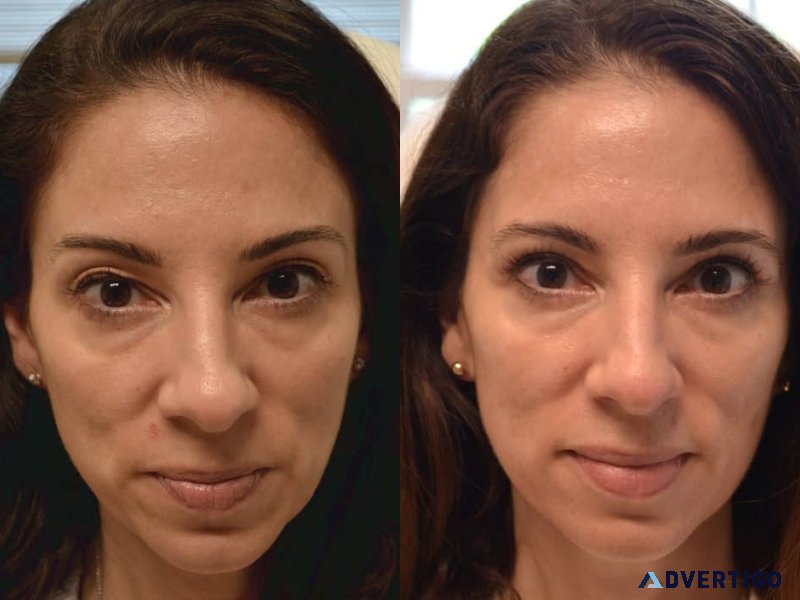
Baggy eyelid surgery
Baggy Eyelid Surgery: What You Need to Know Our skin becomes less elastic as we get older and may start to sag, particularly around the eyes. This might make you look worn out or older, and in certain cases, it can even make your vision worse. A cosmetic technique called baggy eyelid surgery, sometimes referred to as eyelid rejuvenation or eyelid tightening, can help with these issues. Here are some things to consider if you are thinking about having this procedure. What is Baggy Eyelid Surgery Surgery to remove extra skin and fat from the upper and/or lower eyelids is known as baggy eyelid surgery. This can lessen puffiness and dark circles beneath the eyes, as well as enhance the look of drooping or sagging eyelids. Usually, an oculoplastic surgeon or plastic surgeon performs the procedure. There are two main types of eyelid surgery: Upper Eyelid Blepharoplasty: The upper eyelids are surgically reshaped to remove extra skin, muscle, and fat. If the field of vision is blocked by sagging eyelid skin, it may aid enhance vision. Blepharoplasty of the upper eyelid is frequently performed for both practical and aesthetic purposes. Lower Eyelid Blepharoplasty: This surgery addresses wrinkles, puffiness, and under-eye bags by targeting the lower eyelids. To provide a smoother, more youthful appearance, it usually entails the removal or repositioning of extra fat and the tightening of the underlying tissues. HOW DOES BAGGY EYELID SURGERY WORK It can address both upper and lower eyelids. The procedure typically involves the following steps: Consultation: A board-certified plastic surgeon or oculoplastic surgeon should be consulted before beginning any procedure. In order to decide whether you are a good candidate for the operation, the surgeon will examine your eyelids, talk with you about your expectations and goals, and evaluate your general health. Anesthesia: Depending on the extent of the procedure and the patient s preference, either general anesthesia or local anesthesia combined with sedation may be used during a blepharoplasty. Tissue Removal and Repositioning: In the case of upper eyelid surgery, excess skin, muscle, and sometimes fat are removed, and the remaining tissue is repositioned to create a more youthful and refreshed appearance. For lower eyelid surgery, the surgeon may remove or reposition excess fat, redistribute or tighten the underlying muscle, and trim excess skin as necessary. Closure: The incisions are closed with fine sutures or surgical adhesive, which will be removed in the following days or dissolve on their own. Recovery: After the surgery, you will be monitored in a recovery area. You should expect some swelling, bruising, and discomfort, which can be managed with pain medication and cold compresses. It s important to follow your surgeon s post-operative instructions carefully, including keeping your head elevated and avoiding strenuous activities. Results: The results o
-
Category: Health & Beauty
Important!
There are a lot of advertisers on Advertigo. We cannot check them one by one.
You work hard for your money and you want a company you can rely on when you are buying or selling things. That’s why we want to help you protect yourself from fraud. In this section, you’ll find informative tips and other useful material to stay informed and help reduce your chances of falling victim to scammers.
Please understand that Advertigo.net is a free service to help buyers and sellers (and etc.) find one another. Advertigo.net is not involved in any transactions and can not police the actions of our many users.
Useful links
Similar ads
Best urologist in greater noida – expert urological care
Finding the best urologist in Greater Noida ensures top-quality treatment for kidney, bladder, and urinary
Navin Hospitals

Knee pain treatment delhi
Knee pain can limit your mobility and daily activities. SPPC provides expert knee pain treatment
Sppc Healthcare
Physiotherapy center near me
Searching for a trusted physiotherapy center near me? The Physio Experts offer expert rehabilitation solutions
Thephysioexperts

Best knee replacement in ahmedabad
Dr. Jaimin Patel is a trusted Knee Replacement Doctor in Ahmedabad, specializing in advanced surgical
Dr. Jaimin Patel

Robotic knee replacement in ahmedabad
Dr. Jaimin Patel is a highly experienced orthopedic surgeon in Ahmedabad, renowned for his expertise
Dr. Jaimin Patel Orthopedic Surgeon In Ahmedabad
Ayurvedic clinic in kundan nagar
Jeena Sikho Lifecare Ltd. in Kundan Nagar provides excellent Ayurvedic IPD ( In — Patient
Kundan Nagar Clinic
Hair transplant cost vs benefits, invest in your confidence
Are you feeling self-conscious about thinning hair? Always want to walk with full confidence with
Mdaman00Khan

Improve your digestion with a gut health nutritionist
Struggling with bloating, acidity, or digestive issues? A gut health nutritionist can help you restore
Shubham Rai
Permanent hair restoration with fue hair transplant– safe & reli
Isn’t it wonderful to reclaim your youthful look & confidence with FUE Hair Transplantation?Have you
Gaurav

Divyashree height detox: boost your height naturally
Divyashree Height Detox is an Ayurvedic supplement formulated to support natural height growth. Made with
Kayashreeheightdetox